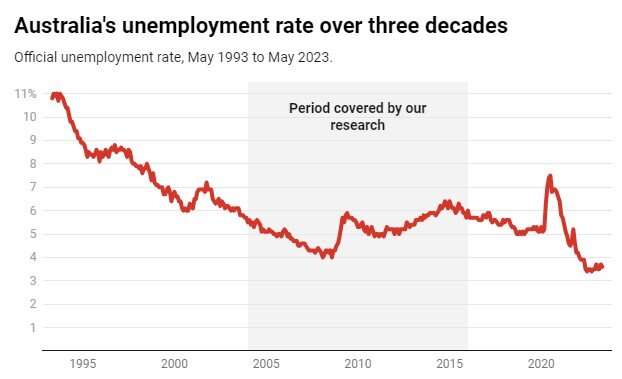This article has been reviewed according to Science X's editorial process and policies. Editors have highlighted the following attributes while ensuring the content's credibility:
fact-checked
peer-reviewed publication
trusted source
written by researcher(s)
proofread
New findings show a direct causal relationship between unemployment and suicide

Studies using traditional statistical methods have long indicated a link between unemployment and suicide. But until now it has been unclear if this relationship is causal. That is, even though the suicide rate is higher among the unemployed, can we definitely say unemployment directly leads to suicide?
We now can. Using advanced analytic techniques borrowed from ecology we have found clear evidence of a causal relationship.
Based on Australian Bureau of Statistics data on underutilized labor and suicide rates, we estimate that unemployment and underemployment in the 13 years from 2004 to 2016 directly resulted in more than 3,000 Australians dying by suicide—an average of 230 a year.
These findings have profound political, economic, social and legal implications, particularly in light of government and central bank policies that "require" unemployment.
How we detected causality
To test for causal effects of unemployment and underemployment on suicide, we applied a technique known as convergent cross mapping.
This method has been developed over the past decade to detect causality in complex ecosystems. Among other things, it has been used to study and show causal relationships between cosmic rays and global temperature, and humidity and influenza outbreaks. The period of our study (2004 to 2016) was bound by the quality of available data.
Challenging economic orthodoxies
A clear relationship between unemployment and suicide challenges governments and institutions to take greater responsibility for the impact of policies and actions. It challenges the ethics of ideas that require some level of unemployment for economic efficiency.
For example, last month the Reserve Bank of Australia's deputy governor, Michele Bullock, said the unemployment rate would have to rise to curb inflation. The central bank expects the unemployment rate to rise to 4.5% by the end of 2024. The current rate is 3.6%, with a further 6.3% of workers underemployed.
As Bullock noted, "full employment" to most people means that anyone who wants a job can find one. But most economists believe there is a need for a certain level of unemployment to prevent inflation.
This level is known as the Non-Accelerating Inflation Rate of Unemployment (NAIRU). It's a theoretical concept, so there's no way to be sure what the level should be, but before the pandemic the consensus was that it was about 5%.
Impetus for far-reaching reform
These findings of the human cost of joblessness bolsters the case for policies to achieve full employment as well as reduce the negative consequences of unemployment, through providing a liveable income and strengthening mental health systems.
Why should the unemployed face deprivation, stigmatization and despair when unemployment is a consequence of deliberate policy decisions?
We hope our findings will spur discussions about expanding unemployment benefits and labor market reforms to achieve greater job security. We also hope to provoke a deeper conversation about the design of the economy and how it values people, beyond simply making money.
Building on the ideas of University of Queensland economist John Quiggin, the Mental Wealth initiative is proposing a social participation wage. Set at the rate of a liveable wage, it would recognize the social value of unpaid volunteer work, civic participation, environmental restoration, artistic and creative activity, and activities that strengthen the social fabric of nations.
Legally there are implications concerning duty of care and the obligation of governments and institutions to safeguard the well-being of the population. These findings should contribute to discussions about legal frameworks relating to employment, work health and safety, discrimination and human rights.
A direct causal relationship between unemployment and suicide demands a re-evaluation of policies, a prioritization of full employment, adequate social safety nets to prevent poverty, mental-health system reform, and greater urgency in shifting to a well-being economy.
More information: Adam Skinner et al, Unemployment and underemployment are causes of suicide, Science Advances (2023). DOI: 10.1126/sciadv.adg3758
Journal information: Science Advances
Provided by The Conversation
This article is republished from The Conversation under a Creative Commons license. Read the original article.![]()




















